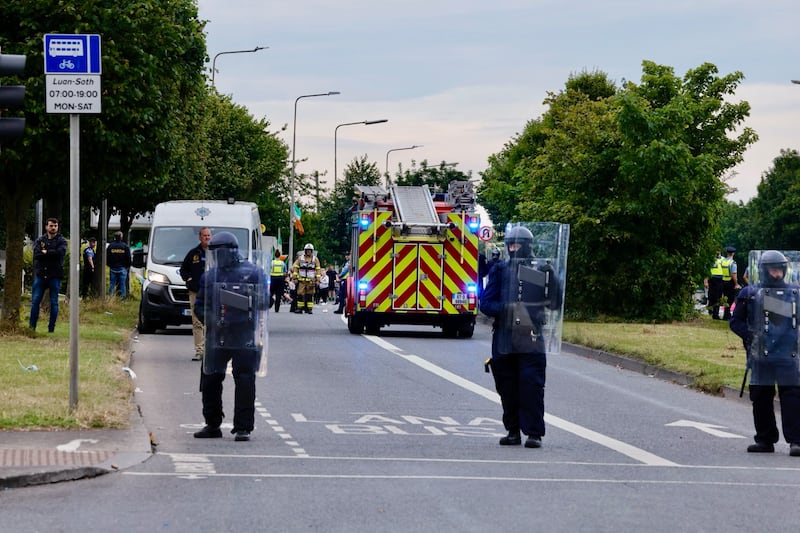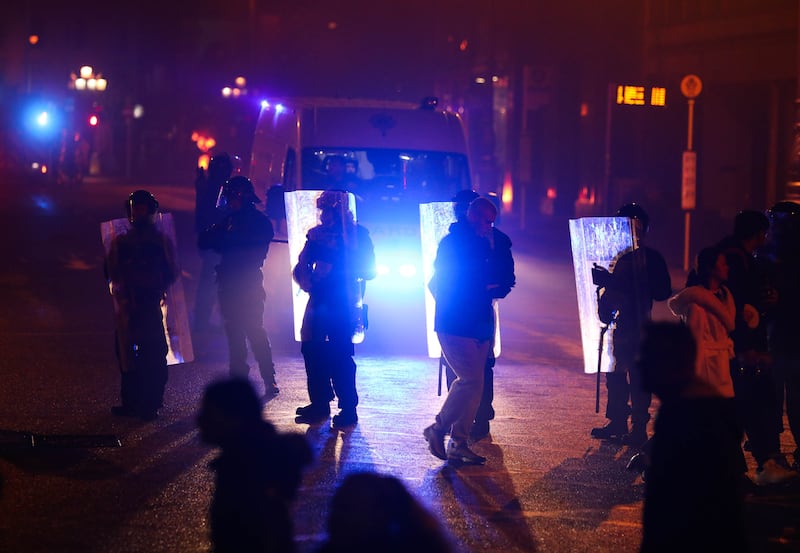Weeks after the Dublin riots that brought destruction to the capital’s streets a year ago on Saturday, Garda Commissioner Drew Harris moved to respond to criticism about the force’s handling of the disorder.
No amount of intelligence gathering could have predicted citywide rioting and looting, he insisted, but he conceded: “There’s learning here for us.”
One year on, has the Garda really learned from the riots, especially after the serious public disturbances at a property earmarked for international protection applicants in July in Coolock, north Dublin?
Events since last November reveal two things. First, there has been a significant ramping-up in the Garda’s preparedness – essentially a tooling-up – for dealing with serious public disorder. Second, the threshold for tolerating violent far-right protesters has been lowered amid a recalibrated Garda approach.
Resources and training
The number of dedicated public order, or riot squad, vehicles has increased to 42 from 27. The new vehicles are purpose-built Mercedes. Two water cannon have also been ordered by the Garda.
The number of Garda members trained for Public Order Unit duties has increased three-fold, to more than 1,500 nationally, though some of that increase predated last November’s riots. Since then, teams of public order officers in vans are on patrol in Dublin from 8am every morning.
Many gardaí complained the incapacitant sprays they had available to overpower people during the riots were too small and not powerful enough. In response, more toxic and larger sprays have been issued.
Among the sizes on offer is one model as large as a conventional fire extinguisher. The Irish Times witnessed the model being deployed in Coolock in July, instantly debilitating whole groups of people.
“It was a gamechanger,” said one garda of the Coolock disturbances. “Once you use this stuff, nobody can cope with it, it just clears the road.”
New shields, of varying sizes and weights, have been purchased as have more modern body armour and riot helmets. The smaller shield option will allow gardaí to wield a baton while also using their shield. The smaller shield size also makes it easier to snatch protesters and pull them behind Garda lines for arrest. That snatch tactic was also seen in Coolock during the summer with large-scale arrests in one day.
Body-worn cameras have also been rolled out in parts of Dublin, Limerick and Waterford. That project was in the planning stages before the riots. Garda sources said the cameras, which can capture footage and sound, will greatly enhance their capacity to identify and arrest violent protesters in follow-up operations, if they are not detained at the scene of an incident.
A major complaint from public order gardaí on duty during the riots was a lack of communication. Their riot helmets were not fitted with earpieces that would have facilitated instructions from commanders or a control room. That was seen as a serious shortcoming and, one year on, it is not resolved, though the process of sourcing those helmets is advancing.
Though just over €3 million has been spent on public order kit since last year, total spending of €12 million is planned for vehicles and kit – body armour, pepper sprays, batons, shields – for 1,000 public order unit members.

Strategy around far right
The main criticism of the Garda in dealing with the far right in recent years is that they have stood back at protest events, allowing incidents that breached criminal law to pass without intervening. This has included threatening and abusive behaviour, a range of other public order offending and assaults. Many social media messages intent on inciting hatred have also clearly breached the law.
The Garda logic, for years, was that moving in to round up and arrest protesters would result in clashes with members of the force that the protesters were trying to provoke. Gardaí said the agitators wanted to capture clashes on video, for social media distribution, so they could use the footage as a recruitment tool.
By standing off, so the Garda logic went, the troublemakers were denied their goal and the numbers at far-right events never really grew much bigger than several hundred.
That theory was wearing very thin even before last November’s riots. A spate of arson attacks at buildings earmarked for international protection applicants and increasingly violent and aggressive forms of protest called into question the policing approach.

But the November riots led to a recalibration of Garda tactics.
Protests outside politician’s homes, once endured, are now being criminally investigated on the basis they constitute harassment. That includes six arrests this year – the first of their kind – for gatherings, by masked men and women, outside the home of Taoiseach Simon Harris in Greystones, Co Wicklow.
In another legal first, a man in his 40s was arrested last month on the suspicion that he created and circulated a social media post falsely claiming that an international protection applicant had exposed himself to women while travelling on a bus to an accommodation centre in Newtownmountkennedy, Co Wicklow.
The post was found to be untrue: disinformation. Its author is now being investigated for allegedly making a false statement giving rise to “apprehension for the safety of persons or property”. The offence is contrary to Section 12(a) of the Criminal Law Act, 1976, which could result in a prison term of up to five years on conviction.
“Even if the DPP doesn’t come back with directions [to charge the suspects] in these cases, it’s a big shift in our approach,” said one Garda source.
Another said: “People know, or they soon will, if they go to politicians’ homes, they can be arrested for just being there. Or if they [publish posts] to whip up fear, it’s the same: criminal investigation, arrest ... the comfort zone is being taken away from them.”
Gardaí have moved much more decisively against other anti-immigration protests. Some 22 arrests were made in Dublin city centre in September when a protest march resulted in a sit-down, with 16 of the suspects charged immediately. In July, when violent clashes broke out in Coolock, more than 30 people were arrested on a day, most of them appearing before the courts immediately.
At the Dundrum House Hotel, Co Tipperary in August, gardaí pushed back protesters to ensure buses of international protection applicants could be brought into the accommodation, with at least one protester being arrested. In June, at least two arrests were made after violent protests, with tyres on Garda cars slashed, in Clonmel, Co Tipperary, where modular homes were being prepared for Ukrainians.
At the River Lodge, known locally as Trudder House, in Newtownmountkennedy, in April, six protesters were arrested and international protection applicants were eventually moved into the facility.
In January, gardaí again forced a path through protesters outside the Racket Hall Hotel outside Roscrea so international protection applicants could be brought in. There were clashes, with at least one arrest.
Since last November’s riots, 57 people have been arrested, with 53 charged with almost 150 offences.
In an unprecedented move – another legal first – Gardaí last Monday issued 99 photographs of “persons of interest” they wanted to identify in relation to the violence and looting.
In four days, 29 had been formally identified and gardaí believe they know the identity of at least 10 to 15 more, based on information from the public.
On Wednesday, Declan Donaghey (28), William Street, Dublin, was jailed for 6½ years for his role in the Dublin riots, including setting a Garda car on fire; a conviction and sentence greeted with delight across the force.
“It’s all about chipping away at them,” said one Garda source.
“The photographs that were sent out this week ... even that alone, that’s a new departure.
“It shows these people if they get involved in this, they won’t be just waltzing off into the sunset; not a week later, not a year later. We have changed the approach on all fronts.”
- Sign up for push alerts and have the best news, analysis and comment delivered directly to your phone
- Join The Irish Times on WhatsApp and stay up to date
- Listen to our Inside Politics podcast for the best political chat and analysis


















